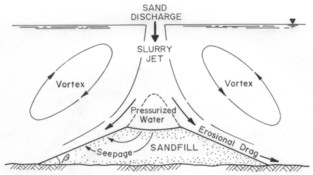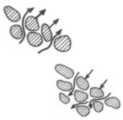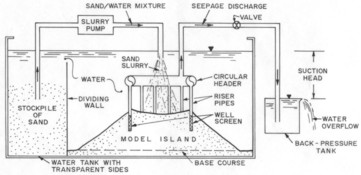
Underwater Sandfills
Discharging a sand slurry into open water from a pipe-line dredge results in a high energy jet of sand and water impinging on top of the submerged sand pile. Impulse-momentum gives rise to destabilizing water pressures which work against the formation of a secure and reliable earthfill.
The end result is a product of so many site variables that behaviour cannot be predicted by rule-of-thumb. You take what you get. And that is usually very flat side slopes requiring huge volumes of fill, as well as poor and variable engineering performance.
Because we believed that it was the excess water seeping out of the growing sand pile that was at the root of all these problems, our idea was simply to reverse the direction of the those powerful deleterious seepage forces, and make them work to advantage.
This can be done by pumping water out of the submerged pile faster than the slurry jet is generating excesses within the mass.



Reversing the direction the water flows through the interface between the saturated sand pile and the sea water totally alters the physics of the slope's stability. The water flow, instead of trying to knock the slope down, allows it to stand even steeper than a dry sub-aerial slope. This procedure should not be confused with de-watering: It is essentially a matter of water circulation. The pumped water can be returned to the sea just above the sand surface; there is no need for it to be brought up to sea level.